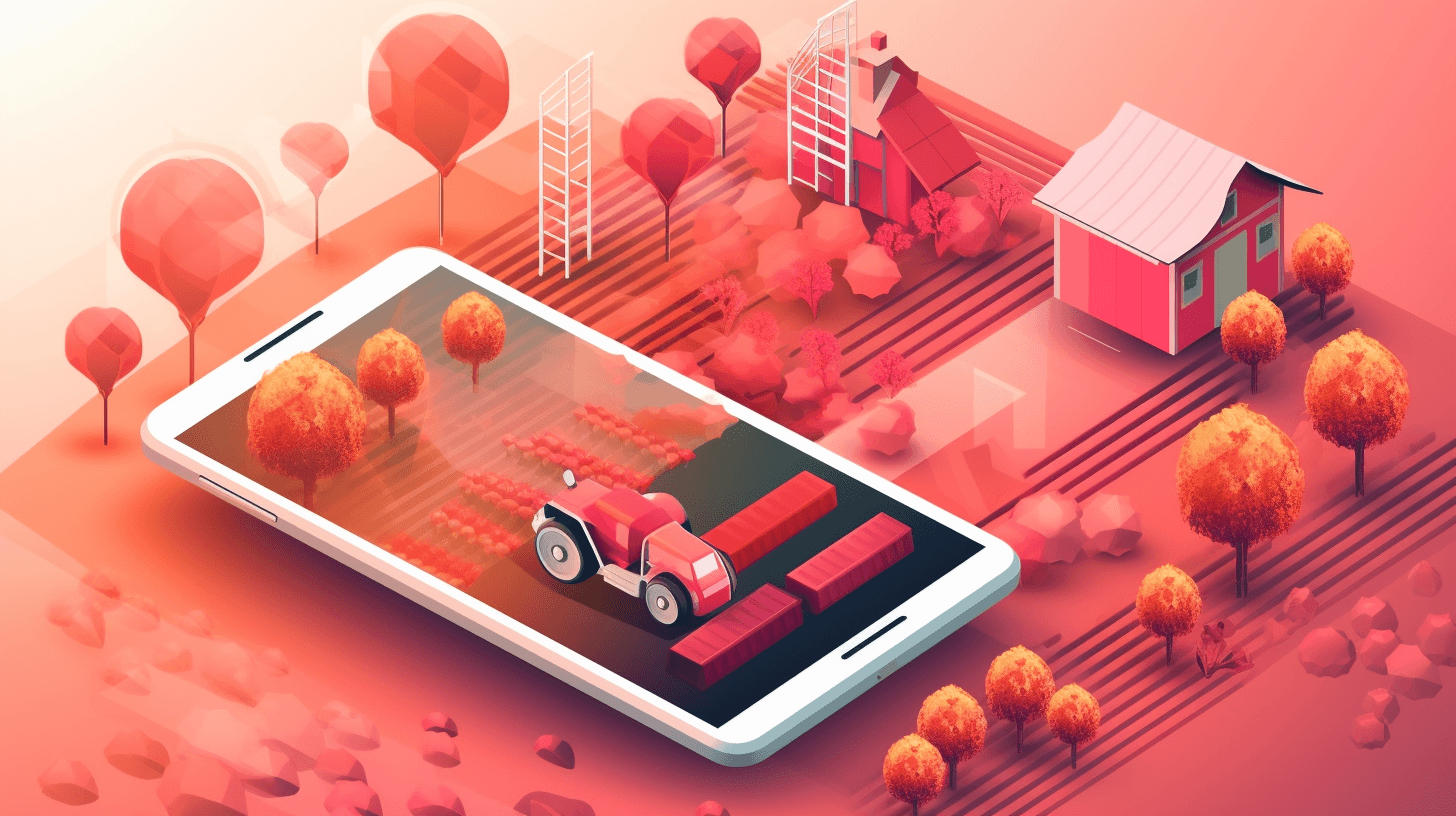Agricultural Apps & AI
Explore the revolutionary integration of AI and AR in agricultural technology

Olena Dontsova
Head of Marketing
09 Jan 2024
18 min read

Welcome to the forefront of agricultural innovation, where the realms of technology and farming intersect to create groundbreaking solutions. In this comprehensive exploration, we delve into the world of Agricultural Apps and Artificial Intelligence, a synergy that's reshaping the agricultural landscape. From the implementation of Farm Management Software (FMS) to the sophisticated use of drones and AI-enhanced irrigation systems, this article navigates through various technological advancements revolutionizing farming. As we journey through these developments, we'll uncover how AI and Augmented Reality (AR) are not just futuristic concepts but practical tools driving efficiency, productivity, and sustainability in modern agriculture.
1. Farm Management Software (FMS)

Granular
A comprehensive farm management software that aids farmers in decision-making by analyzing operational, financial, and agronomic data.
- Benefits: Comprehensive decision-making support by analyzing operational, financial, and agronomic data.
- Technology: Cloud-based software, data analytics, mobile applications.
- Market Share: One of the top FMS players, but specific % would need current research.
AI/AR Improvement: By using AI, Granular can offer predictive analytics on crop yields, pest infestations, and soil health. With AR, farmers could visually map out their field plans and see a projected overlay of their crop rotations directly on the land.
FarmLogs
Helps farmers monitor field conditions, manage operations, and track finances. AI/AR Improvement: Incorporating AI could refine their real-time data analysis, providing immediate alerts or suggestions based on changing field conditions. AR could allow farmers to 'see' under the soil, visualizing moisture or nutrient levels.
- Benefits: Real-time monitoring of field conditions, operations management, financial tracking.
- Technology: Satellite imagery, cloud computing, mobile apps.
- Market Share: Significant presence in the U.S., especially among smaller to mid-size farms.
Agworld
A collaborative farm management system that allows farmers, agronomists, and contractors to work together on a single platform.
- Benefits: Collaboration platform for all stakeholders, from farmers to contractors.
- Technology: Cloud computing, mobile applications, integration capabilities.
- Market Share: Strong presence, especially in Australia.
AI/AR Improvement: Collaboration on Agworld could be enhanced using AI to analyze shared data and provide actionable insights. AR could allow for real-time collaborative visual planning on fields.
2. Precision Agriculture

John Deere Operations Center
Offers a suite of tools that allow farmers to optimize machinery, monitor field conditions, and maximize yield.
- Benefits: Optimize machinery operations, real-time field monitoring, maximize yield.
- Technology: IoT, machine learning, cloud computing.
- Market Share: Given John Deere's dominance in agricultural machinery, it has a substantial share, especially in North America.
AI algorithms could further optimize machinery routes and timings. AR could provide operators with overlays of field health and machinery efficiency while operating.
Trimble Ag Software
A platform that provides solutions for crop planning, soil monitoring, and yield tracking.
- Benefits: End-to-end platform for crop planning, soil monitoring, yield tracking.
- Technology: GPS, data analytics, cloud computing.
- Market Share: Significant due to Trimble's broad product range and global presence.
With AI, data analysis for soil monitoring could become more precise. Using AR, farmers could get a visual representation of soil health while walking their fields.
Climate FieldView
Captures real-time plant data and provides actionable insights on field health and productivity.
- Benefits: Captures real-time plant data, insights on field health.
- Technology: IoT, data analytics, machine learning.
- Market Share: A leading platform, especially in North America.
AI can provide predictive insights on crop health and growth. AR could allow farmers to see projected growth stages on their crops as they inspect them.
3. Drones in Agriculture

DJI Agras Series
Specifically designed for agricultural spraying, these drones ensure precision and efficiency.
- Benefits: Precision in agricultural spraying, efficiency.
- Technology: Drone technology, GPS, image recognition.
- Market Share: DJI is a dominant player globally in the drone market, with its Agras series being popular for agricultural uses.
AI can enhance precision in identifying where to spray. AR integration would allow real-time visual feedback to operators on areas covered and missed.
Parrot Bluegrass Fields
An agricultural drone designed to provide comprehensive insights through aerial imagery.
- Benefits: Aerial imagery insights, crop monitoring.
- Technology: Drone technology, image analysis.
- Market Share: Parrot is a significant name, but DJI has a larger global presence.
AI can improve image analysis for identifying crop health. AR could give farmers a live overlay of problem areas while viewing footage.
SenseFly eBee SQ
An advanced agricultural drone used for crop scouting and high-precision agriculture.
- Benefits: High-precision agriculture, crop scouting.
- Technology: Advanced drone tech, aerial imaging.
- Market Share: Niche but notable in the professional agricultural drone segment.
AI could refine image recognition capabilities for better crop scouting. AR could enhance post-flight analysis by overlaying identified issues on real-world terrain.
4. Irrigation Systems

Rain Bird
A leader in irrigation systems, Rain Bird offers solutions that can be customized for varying field sizes and types.
- Benefits: Customizable irrigation solutions suitable for diverse field sizes/types.
- Technology: IoT for smart irrigation, cloud computing for data management.
- Market Share: A leader in the irrigation sector with a significant global presence.
AI can optimize water usage based on predictive analytics of weather and soil data. With AR, farmers can see water distribution patterns in real-time on their fields.
Netafim
Specializes in drip and micro-irrigation products, ensuring efficient water usage.
- Benefits: Efficient water usage via specialized drip and micro-irrigation products.
- Technology: Smart irrigation tech, data analytics for optimal water distribution.
- Market Share: Recognized globally, especially in regions where water efficiency is critical.
AI can adjust drip timings based on plant health and soil conditions. AR could allow farmers to visualize soil moisture levels beneath the surface.
Jain Logic
Provides real-time data on soil moisture and weather, helping farmers optimize their irrigation schedules.
- Benefits: Real-time soil moisture and weather data for optimized irrigation.
- Technology: IoT soil sensors, cloud computing, predictive analytics.
- Market Share: Significant, especially in areas focusing on precision irrigation.
AI could refine moisture and weather data analysis for better irrigation recommendations. AR visualization of moisture data can assist farmers in understanding their field's irrigation needs.
5. Greenhouse Farming
Priva
Offers comprehensive solutions for managing greenhouse climates, ensuring optimal conditions for plant growth.
- Benefits: Effective management of greenhouse climates for optimal plant growth.
- Technology: Climate control tech, cloud-based data management.
- Market Share: One of the top players in the greenhouse tech sector globally.
AI can adjust the greenhouse environment based on plant health indicators. AR could help staff visualize temperature or humidity imbalances in the greenhouse.
Motorleaf
Uses AI to automate and optimize greenhouse operations, from yield prediction to environmental controls.
- Technology: AI, machine learning for yield prediction and environmental controls.
- Market Share: Growing presence, especially among tech-forward greenhouses.
While already AI-driven, it can further refine yield predictions and disease detection. AR could provide workers with overlays of plant health status as they navigate the greenhouse.
Grodan
Focuses on providing insights and data-driven solutions for sustainable greenhouse cultivation.
- Technology: Data analytics, cloud computing.
- Market Share: Well-established in the realm of sustainable greenhouse farming.
AI can offer personalized advice for crop cultivation. With AR, users can get real-time data overlays on individual plants.
Leaf
A software provider that simplifies the process of integrating agricultural APIs. They offer a platform that makes it easier for developers and businesses to access and utilize farm data from multiple sources.
- Benefits: Centralized Data Platform: It simplifies the digital agriculture world by integrating various data sources into one platform, streamlining decision-making.
- Interoperability: Provides API connectors to various ag-tech tools, creating a more unified farm management approach.
- Real-time Insights: By integrating various data streams, Leaf offers a holistic view of farm operations in real-time.
- Technology
- API Integration: The core of Leaf's platform is its ability to connect with a plethora of ag-tech tools, making data integration seamless.
- Cloud Computing: Offers scalable storage and processing capabilities.
- Data Analytics: Provides actionable insights from integrated data.
- Market Share: Given the unique niche that Leaf operates in, it doesn't have a direct comparison with traditional FMS tools. Its market share would be smaller compared to comprehensive FMS platforms but is growing, especially among farmers and agronomists who use multiple digital tools and seek a unified data dashboard.
- AI/AR Improvement: If we consider Leaf Agriculture, AI could enhance the platform by offering predictive analytics based on the aggregated farm data, while AR could allow developers to visualize this data in a more interactive and intuitive manner.
6. Livestock Monitoring
Cowlar
A collar-based system for cows that offers insights into animal health and behavior.
- Technology: IoT wearables, data analytics.
- Market Share: Gaining traction, especially in tech-adopting livestock farms.
AI can enhance behavioral analysis to predict diseases earlier. Using AR glasses, farmers could see health stats when looking at each cow.
Allflex Livestock Intelligence
Offers monitoring solutions for dairy cows, beef, and calves, providing insights into reproductive, health, and nutritional status.
- Technology: IoT wearables, cloud data management.
- Market Share: One of the leading players in livestock monitoring worldwide.
AI can refine reproductive and health monitoring for quicker interventions. AR visual aids could show health indicators when observing livestock.
Moocall
Monitors livestock, especially around calving, ensuring timely intervention when required.
- Technology: IoT devices, mobile notifications. = Market Share: Notable, especially in regions with large cattle farming operations.
AI can improve the accuracy of calving alerts. AR can provide visual cues to farmers on which animals are nearing calving.
7. Weather Forecasting for Agriculture
IBM's The Weather Company
Provides hyper-localized weather predictions, which are invaluable for agricultural planning.
- Technology: Advanced weather modeling, cloud computing.
- Market Share: Significant, given IBM's global presence and tech integration.
AI can enhance hyper-localized predictions with greater accuracy. AR could provide farmers with a visual forecast overlay on their fields.
AccuWeather
Offers localized weather forecasts, alerts, and insights which can be tailored for farmers.
- Technology: Advanced meteorological data analytics.
- Market Share: One of the top global players in weather forecasting.
AI can refine localized alerts tailored for agricultural needs. AR could visualize upcoming weather patterns directly on farm terrains.
aWhere
Provides agronomic weather data and insights, helping farmers understand how weather patterns might impact their crops.
- Technology: Data analytics, predictive modeling.
- Market Share: Growing, especially among farmers emphasizing data-driven practices.
AI can enhance agronomic weather data analysis. With AR, farmers could visualize potential weather threats in real-time on their crop..
In our exploration of Agricultural Apps and AI, we've been fascinated by the dynamic intersection of technology and agriculture that's reshaping the farming landscape. Our journey began with an examination of farm management software like Granular, FarmLogs, and Agworld, where we observed how AI aids in predictive analytics and AR in enhancing field planning. The advancements in precision agriculture, particularly by companies like John Deere and Trimble Ag Software, caught our attention for their role in optimizing farm operations through advanced technology.
As we delved deeper, the use of specialized agricultural drones, notably the DJI Agras Series, emerged as a pivotal innovation for precision and efficiency in agricultural practices. We were equally impressed by how smart irrigation systems like Rain Bird and Netafim leverage AI for intelligent water management, steering farming towards sustainability. The impact of AI in livestock monitoring and tailored weather forecasting was another key area that stood out to us, demonstrating how technology offers crucial, accurate data to farmers for better decision-making.
Exploring the greenhouse sector, with companies like Priva and Motorleaf utilizing AI for climate control and plant growth optimization, opened our eyes to the potential of controlled environment agriculture. Finally, the idea of developing a Minimum Viable Product (MVP) for an agricultural app highlighted the growing need for comprehensive, integrated, and AI-driven solutions in the agricultural sector. Through this exploration of Agricultural Apps & AI, we've gained a deep appreciation for the transformative role of technology in fostering more efficient, effective, and sustainable farming methods.